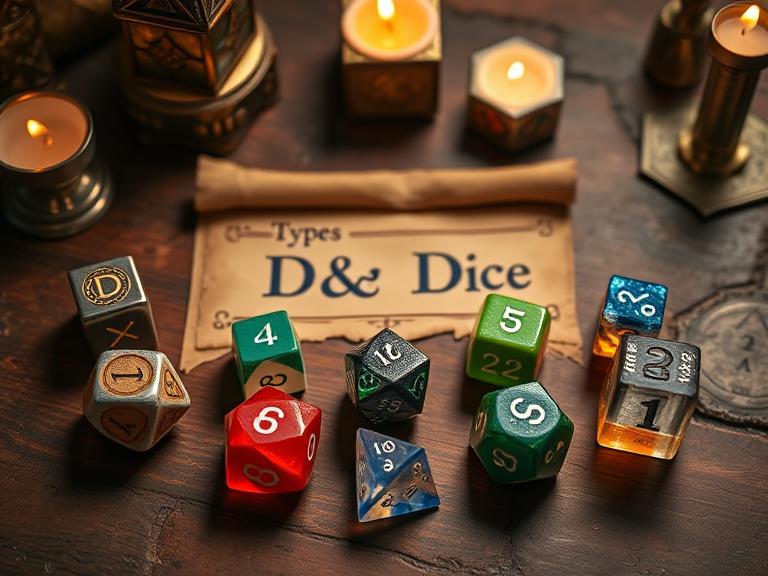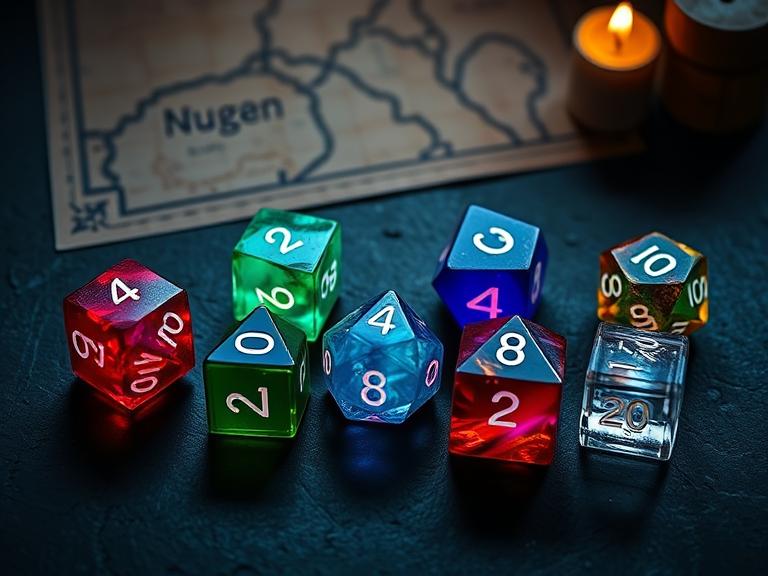From dusty taverns and dark dungeons to epic battles against dragons, the many types of DnD dice have helped shape every unforgettable adventure. Dungeons & Dragons (D&D) has long captivated adventurers. At the heart of every spell cast, sword swung, and sneaky Stealth check lies something essential: dice. Not just any dice, but a special collection known as polyhedral dice. These aren’t just tools; they’re the soul of role-playing games (RPGs). If you’re asking yourself, “What are the different DnD dice used for?” you’re in the right place.

What is D&D Dice?
In D&D, dice are more than just numbers; they represent randomness, chance, and choice. The dice set includes the classic polyhedral types: four-sided (d4), six-sided (d6), eight-sided (d8), ten-sided (d10), twelve-sided (d12), twenty-sided (d20), and a percentile die (d%). These polyhedral dice are essential for combat, spellcasting, character development, and decision-making in the game.
The 7 Types of DnD Dice
Let’s break down each one from your dice pouch:
1. D4 – The Pyramid
- Shape: Four-sided, triangular pyramid.
- Used For: Small weapon damage like daggers or spells like Magic Missile.
- Fun Fact: Often painful to step on, just ask any player barefoot at the table.
2. D6 – The Classic Cube
- Shape: Standard six-sided die (think Yahtzee or Risk).
- Used For: Weapon damage, spell effects, and 4d6 ability score generation.
- Most Recognized: It’s the only D&D die you’ll also find in Monopoly.
3. D8 – Clubs and Crossbows
- Shape: A multi-sided form resembling two pyramids joined at their bases.
- Used For: Light crossbows, Morningstars, and various spells.
- Balance: Good middle ground for mid-tier weapons.
4. D10 – The Spellcaster’s Ally
- Shape: Ten sides, with a smooth, rounded look.
- Used For: Higher-level spells and weapons like Longswords.
5. D% – Percentile Dice
- Shape: A pair of d10s (one marked in tens).
- Used For: Random events, loot tables, and D100 rolls (like “What rare magic item did you find?”).
6. D12 – The Barbarian’s Friend
- Shape: A twelve-sided die.
- Used For: Greataxes, certain spells, and high-damage combat options.
7. D20 – The Decision Maker
- Shape: Iconic twenty-sided die.
- Used For: Most checks, saving throws, skill checks, attack rolls, etc.
- Fame: Central to D&D’s mechanics; often called the “core die”.
DnD Dice Rolls Explained
In D&D, nearly every action is resolved using a dice roll. The most common is the d20 roll, used to determine success or failure. Here are the main types:
- Ability Checks: Roll a d20 and add modifiers (e.g., Stealth or Persuasion).
- Saving Throws: Resist effects like poison or fire.
- Attack Rolls: Determine whether you hit your opponent.
- Damage Rolls: Use different dice based on weapon or spell.
Modifiers, critical failures (natural 1), and super-successes (natural 20) add depth and unpredictability.
Types of DnD Dice Rolls
Different roles call for different dice or combinations:
- 1d6 = Roll one six-sided die.
- 2d10 = Roll two d10s.
- 3d8 = Roll three d8s.
- 1d6 + 4 = Add modifier after rolling one d6.
These formulas are found in spells, weapons, and character sheets. Understanding them is essential for smooth gameplay.

D&D Dice Chart
| Dice | Shape | Typical Use |
| D4 | Pyramid | Daggers, Magic Missile |
| D6 | Cube | Shortswords, Firebolt, Ability Rolls |
| D8 | Double Pyramid | Morningstars, Spell Damage |
| D10 | Pentagonal Trapezohedron | Longsword, Divine Smite |
| D% | Pair of d10s | Percentile Rolls, Magic Items |
| D12 | Dodecahedron | Greataxe, High-Damage Weapons |
| D20 | Icosahedron | Skill Checks, Saving Throws |
This chart serves as a quick DnD dice reference at the table.
Types of DnD Dice Sets
Standard Polyhedral Sets
- 7-piece set: d4, d6, d8, d10, d%, d12, d20.
- Available in starter kits, often in bright colors or basic plastic.
Expanded and Themed Sets
- Custom Sets may include extra d6s or d20s for games with lots of attacks.
- Glow in the Dark Dice, translucent, or speckled dice are popular among collectors.
Unique Dice Sets
- Designed for flair or specific campaigns.
- Gemstone, wood, glass, and metal dice draw attention to any table.
Types of DnD Dice Materials
Material choice impacts roll feel, sound, and durability:
| Material | Pros | Cons |
| Acrylic | Inexpensive, light, colorful | Less durable |
| Resin | Artistic, slightly heavier | May chip over time |
| Metal | Heavy, premium look and feel | Loud, may damage soft surfaces |
| Stone/Gem | Stunning visuals | Fragile, expensive |
| Wood | Eco-friendly, rustic | Not perfectly balanced |
Fifty Years of Dice and Dragons: A Journey Through DnD’s Legendary Legacy
From humble beginnings in the 1st edition to the rule-rich 5th edition, dice in D&D have evolved. Early players used borrowed dice from Yahtzee or craps, but today, you’ll find premium dice sets, custom DnD dice, and even thirty-six-sided dice used in homebrew campaigns.
Each decade introduced more mechanical depth, driving dice to become not just tools, but collectables.
What Are the Different DnD Dice Used For?
Here’s a breakdown of how each die supports gameplay:
- D4: Damage from light weapons or basic spells.
- D6: Weapon damage, HP rolls, and ability generation.
- D8: Common for melee weapons and spell damage.
- D10 & D%: Used for percentile tables, magical effects.
- D12: Heavy-hitting melee attacks.
- D20: The backbone of D&D decision-making.
Each shape fits a unique purpose in your character’s journey, from tavern brawls to divine interventions.
How to Use DnD Dice in Gameplay
- Roll when prompted by the Dungeon Master (DM).
- Add your character’s modifiers (from the character sheet).
- Compare your total to the Difficulty Class (DC).
- Describe the outcome, good or bad, through role-play.
Knowing how and when to roll is as important as strategy itself.
DnD Dice Roller Tools (Digital Dice Options)
For players without physical dice or playing online:
- Digital Dice Rollers: Websites or apps like D&D Beyond, Roll20, and Dice Maiden.
- Fairness: These platforms often use random number generators (RNGs) with balanced results.
- Great for remote gaming, and you’ll never lose a die again.
Still, many players prefer the feel and chaos of physical dice rolling.
Choosing the Best Dice for D&D
So what’s the best dice set? It depends on:
- Your Budget: Acrylic for beginners, gemstone for collectors.
- Your Character: Rogues may love sleek black dice; Wizards might go for glittering arcane colors.
- Your Play Style: Heavy metal dice or soft wood ones, whatever feels right in your hand.
How Many Types of DnD Dice Are There?
While 7 standard types exist, dice have been created for special campaigns, homebrew rules, and rare rolls. Some campaigns may even invent custom dice!
So, the answer is:
- 7 core types (standard in all sets)
- 10+ types if including homebrew and custom designs
Common Questions Answered
How many types of dice are in D&D?
There are 7 standard types used in official rules: d4, d6, d8, d10, d12, d20, and percentile dice (d%).
What are the 7 DnD dice?
They include: d4, d6, d8, d10, d12, d20, and d100 (made from two d10s).
What type of dice is best for D&D?
That depends on preference. For durability, choose metal. For readability, use opaque or bright resin. For luxury, try gemstone dice.
What is the most commonly used dice in D&D?
The d20 determines success or failure in most game mechanics.
Conclusion
Whether you’re a new player assembling your first character or a seasoned Dungeon Master curating a premium dice set, understanding the types of DnD dice elevates your gameplay. Each die has its own role, history, and energy, and no two rolls are ever the same.
So, next time you sit at the table, roll with confidence. Your fate, like your dice, is polyhedral.
